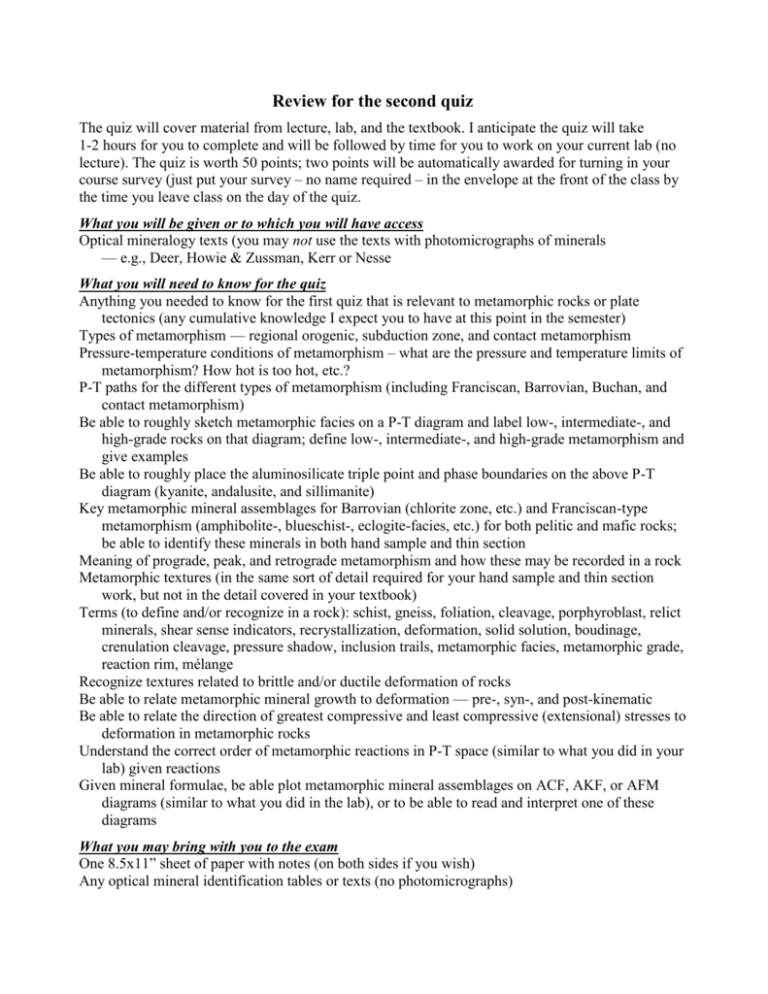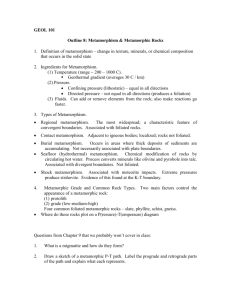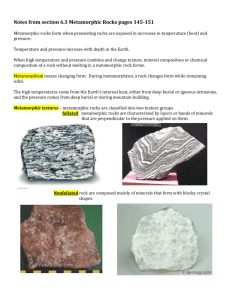Topics for review for Quiz 2
advertisement

Review for the second quiz The quiz will cover material from lecture, lab, and the textbook. I anticipate the quiz will take 1-2 hours for you to complete and will be followed by time for you to work on your current lab (no lecture). The quiz is worth 50 points; two points will be automatically awarded for turning in your course survey (just put your survey – no name required – in the envelope at the front of the class by the time you leave class on the day of the quiz. What you will be given or to which you will have access Optical mineralogy texts (you may not use the texts with photomicrographs of minerals — e.g., Deer, Howie & Zussman, Kerr or Nesse What you will need to know for the quiz Anything you needed to know for the first quiz that is relevant to metamorphic rocks or plate tectonics (any cumulative knowledge I expect you to have at this point in the semester) Types of metamorphism — regional orogenic, subduction zone, and contact metamorphism Pressure-temperature conditions of metamorphism – what are the pressure and temperature limits of metamorphism? How hot is too hot, etc.? P-T paths for the different types of metamorphism (including Franciscan, Barrovian, Buchan, and contact metamorphism) Be able to roughly sketch metamorphic facies on a P-T diagram and label low-, intermediate-, and high-grade rocks on that diagram; define low-, intermediate-, and high-grade metamorphism and give examples Be able to roughly place the aluminosilicate triple point and phase boundaries on the above P-T diagram (kyanite, andalusite, and sillimanite) Key metamorphic mineral assemblages for Barrovian (chlorite zone, etc.) and Franciscan-type metamorphism (amphibolite-, blueschist-, eclogite-facies, etc.) for both pelitic and mafic rocks; be able to identify these minerals in both hand sample and thin section Meaning of prograde, peak, and retrograde metamorphism and how these may be recorded in a rock Metamorphic textures (in the same sort of detail required for your hand sample and thin section work, but not in the detail covered in your textbook) Terms (to define and/or recognize in a rock): schist, gneiss, foliation, cleavage, porphyroblast, relict minerals, shear sense indicators, recrystallization, deformation, solid solution, boudinage, crenulation cleavage, pressure shadow, inclusion trails, metamorphic facies, metamorphic grade, reaction rim, mélange Recognize textures related to brittle and/or ductile deformation of rocks Be able to relate metamorphic mineral growth to deformation — pre-, syn-, and post-kinematic Be able to relate the direction of greatest compressive and least compressive (extensional) stresses to deformation in metamorphic rocks Understand the correct order of metamorphic reactions in P-T space (similar to what you did in your lab) given reactions Given mineral formulae, be able plot metamorphic mineral assemblages on ACF, AKF, or AFM diagrams (similar to what you did in the lab), or to be able to read and interpret one of these diagrams What you may bring with you to the exam One 8.5x11” sheet of paper with notes (on both sides if you wish) Any optical mineral identification tables or texts (no photomicrographs)








